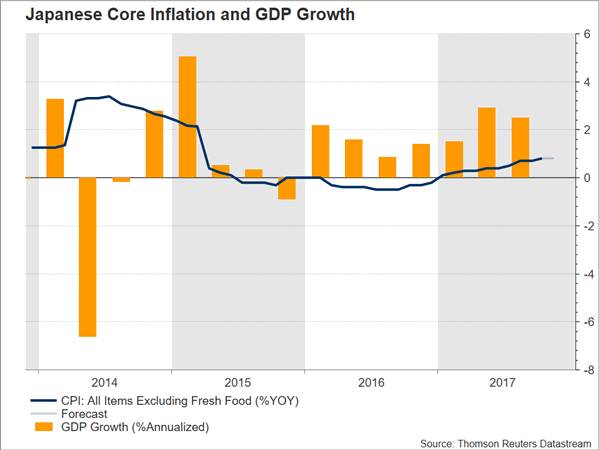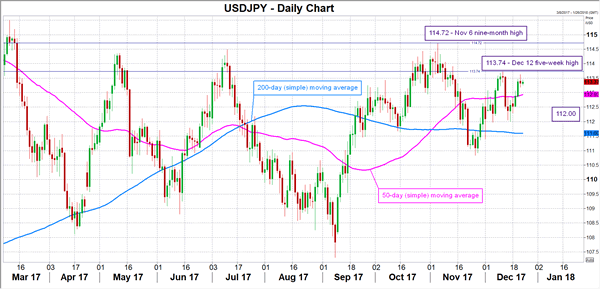Japan will see the release of November inflation figures on Monday at 2330 GMT. Core inflation, the measure targeted by the Bank of Japan, is expected to remain steady at 0.8% on an annual basis, well below the central bank’s target of 2.0%.
Despite core CPI undershooting the BoJ’s target and being one of the reasons the bank decided in its latest meeting to maintain its ultra-loose monetary policy, a positive figure would reflect the 11th consecutive rise for the measure, with the overall trend throughout this period being a positive one as well. Still, inflationary pressures remain subdued despite economic activity gaining some positive momentum – in the third quarter of the year the Japanese economy recorded positive growth for the seventh straight quarter, this being the longest such stretch since the period between Q2 1999 and Q1 2001 during which the economy expanded for eight straight quarters.

According to analysts, core CPI, which includes oil products but excludes more volatile fresh food prices, is expected to have faced downward pressure from easing utility costs and upward pressure from rising oil product prices, such as gasoline, during November.
December Core CPI in Tokyo is anticipated to grow by 0.7% y/y. November’s respective figure was at 0.6%.
An upside surprise in inflation figures is expected to lend support to the Japanese currency, pushing dollar/yen lower. In such an event, the pair could find support around the current level of the 50-day moving average at 112.93, with steeper declines shifting the focus to the range around the 112.00 mark which was fairly congested recently.
Should CPI numbers disappoint though, dollar/yen is anticipated to advance as forex market participants will likely push further back in time any expectations for monetary policy normalization by the BoJ. In this case, dollar/yen might find resistance around December 12’s more than five-week high of 113.74. Stronger bullish movement would eye the nine-month high of 114.72 that was recorded on November 6 as an additional barrier to the upside. The area around this level encapsulates other tops from the recent past, something which perhaps increases its significance.

Numbers on household spending, the jobs-to-applicants ratio and the unemployment rate all for the month of November will be released at the same time as inflation figures. These also have the capacity to spur positioning on the Japanese currency. Household spending is projected to have grown by 0.5% y/y after October’s zero growth. The unemployment rate is anticipated to remain at the 23-year low of 2.8% and the jobs-to-applicants ratio is forecast to come at 1.56, its highest since January 1974.
Other Japanese data out next week include November’s industrial output and retail sales figures. Both are due on Wednesday at 2350 GMT. The BoJ will also be publishing its minutes of the October 30-31 policy meeting on Monday (2350 GMT) and the summary of opinions of the December meeting on Wednesday (2350 GMT).












